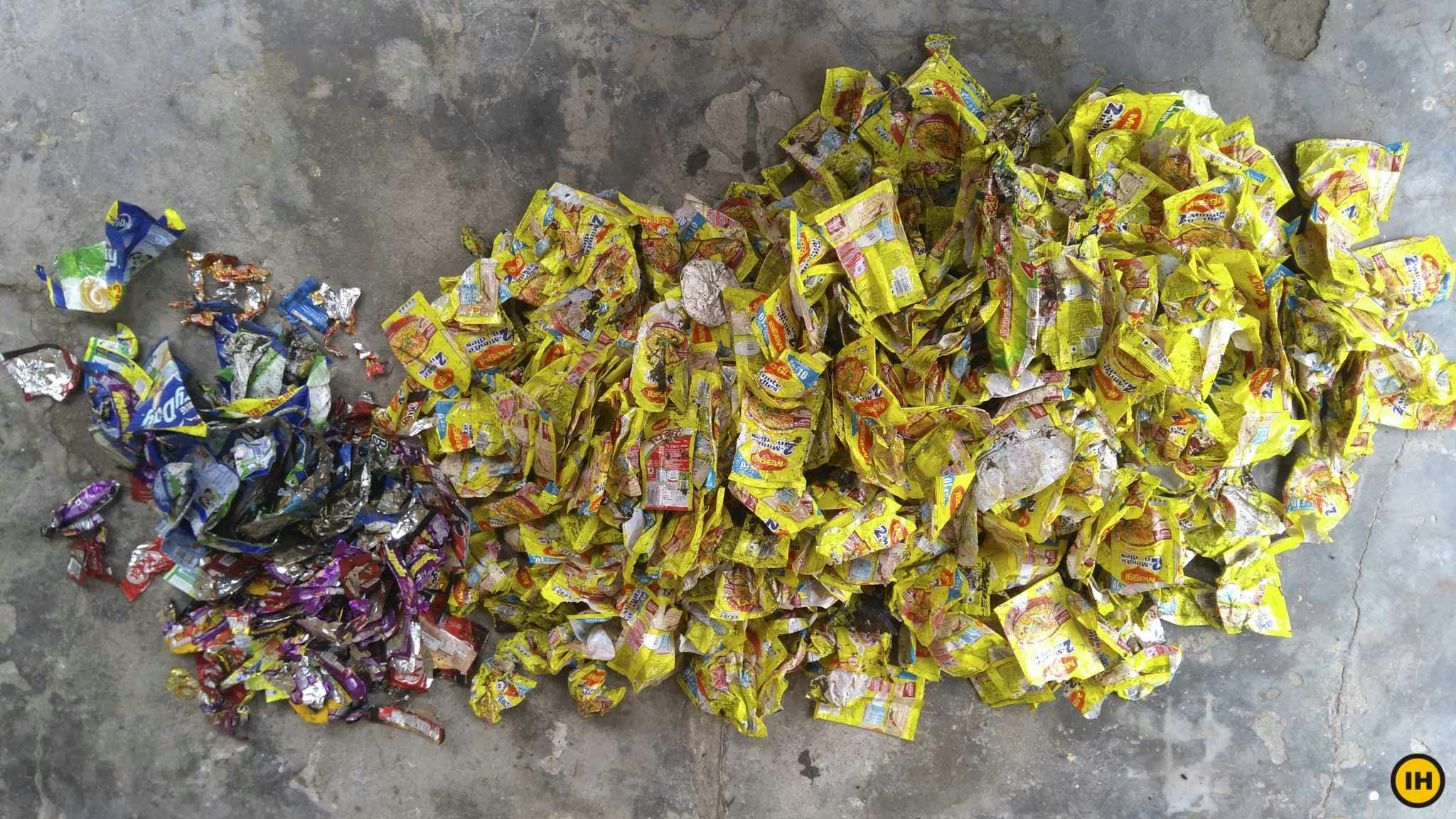Maggi or the Mountains, What Will You Choose?
Share this story
Maggi or the Mountains, What Will You Choose?
Category Green Trails Green Trails Impact Reports Sustainability Resources
By Ori Gutin
2017-12-12
When I started working for Indiahikes in June 2017 as a Green Trails Intern on the Roopkund slope, I was amazed at the amount of trash we were removing from the mountains.
Every day, more and more sacks of unwanted mountain garbage would come down to us at base camp, waiting to be sorted and sent to the environmentally-correct destination. That meant that nearly every day, my coworkers and I were knee deep in muddy, sometimes maggot-filled waste, separating banana peels from crumpled up aluminum foil, and empty whiskey bottles from old torn up t-shirts, and so on.
I might be the odd-one-out here, but I absolutely loved it! It was so fulfilling to see the sorted and weighed bags pile up as the internship went on. Ultimately, we removed over 3,000 kg of waste from Roopkund in just one summer!
Is cleaning up trails really enough?
As much as I loved my work, I couldn’t help thinking that this was like putting a band-aid on the issue, rather than preventing the wound in the first place. I constantly wondered, “what could be done to prevent this waste from ending up in the mountains?”
And that’s when it occurred to me that we needed to figure out what was in our waste before we could figure out how to cut it off at the source. Thus was born the “Himalayan Waste Audit of Summer 2017!”
The idea was simple. Instead of sorting our waste and sending it right away, we would analyze what was coming down to us from the mountains to understand which companies and which types of products were responsible for the greatest percentage of litter. Once we knew that information, perhaps we could create a more focused strategy to limit those sources of waste entering the precious mountain landscapes to begin with.
Himalayan Waste Audit, Summer 2017
We conducted this audit at two locations, Hampta Pass and Roopkund. We did this in places 765 km apart in order to avoid any localized trash patterns.
When bags of waste were brought down from the mountains, instead of mindlessly segregating them, we diligently recorded the manufacturer and type of each product to discern waste patterns. We chose to audit only “identifiable plastics,” meaning any type of plastic wrapper that had a brand name on it. This is because plastics cause the most harm to the mountain ecosystems.
Following this process, we audited 5,243 pieces of identifiable plastics at Hampta Pass and Roopkund. Some of the results were quite shocking. You can see the full results of the audit in the table below.
*Waste count does not include numbers from Roopkund audit. These companies did not fall in the top 10 waste producers and thus were not recorded. Total waste from these companies in the Roopkund audit was less than 25 pieces.
What we learnt from the Audit results
There are several takeaways from these results. For the purpose of this article, I’m going focus more on Nestle. Let us consider these facts:
- Nestlé was responsible for 20.2% of all pieces of waste that we audited. This means slightly over 1 out of 5 plastic wrappers you pick up in the mountains is a Nestlé product.
- The vast majority of Nestlé products were noodle and chocolate bar wrappers. These are much larger in size when compared to hard candy wrappers. Parle, the number two polluter, which represented half the amount of waste of Nestlé, was nearly 61% hard candy wrappers.
- Nestlé came in first in both audits, with 18.6% of waste at Roopkund, and 20.7% of waste at Hampta. The 2.1% difference between the two audits was amongst the smallest differences of any company at the two sites, meaning that this is in no way a localized phenomenon.
- The total weight of Nestlé’s waste was 3.25 kg across both audits. That represents 1.46% of the 221.94 kg of waste we removed from the mountains for this project (including all waste: glass, metal, plastics, etc.) On average, Indiahikes removes roughly 12,000 kg of waste from the mountains annually. Extrapolating with the percentages from this audit, that means that we’re removing around 175 kg of Nestlé waste alone from the Himalayas each year. And finally,
- There were 616 Maggi Noodle wrappers discovered in the audit. Just that product alone represents 11.75% of all waste audited, nearly a full percentage point higher than the 10.8% of the next closest manufacturer, Parle.
All of these numbers astounded me, but that last fact literally made my jaw drop. The fact that one product alone is so responsible for Himalayan waste left me awe struck, for two reasons.
One, because it is so unfortunate that our desire to eat Maggi noodles on a trek is stronger than our desire to experience the purest beauty of the mountains on a trek.
Two, because by focusing on changing just one eating habit of trekkers, we could cut off 11.75% of Himalayan waste at the source – what an incredible opportunity!
Is it really possible to reduce waste at source in the Himalayas?
But we can’t make use of this opportunity alone. We need the help of every single person who has ever come on a trek with us. We need you to look deep inside yourself, and make a choice, “Maggi or the Mountains?”
I won’t lie. There are few things better than slurping down a hot plate of fresh Maggi noodles after a long, cold, and tiring day in the mountains.
But it just so happens that one of those things is being able to experience the mountains free of trash, in the way they’ve been for the last few million years – in the way they’re meant to be. And no matter how much you love Maggi, I bet you won’t argue with that.
So, if you’re on a trek with us, with another company, or on your own, we sincerely ask you to resist the urge to go over to the dhaba and order a plate of Maggi. It might seem absolutely harmless in the moment, but chances are that the person running the dhaba cannot afford to send his waste out of the mountains. Which means, that Maggi wrapper will either end up contaminating soils, harming wildlife, and polluting waterways, or being burned in a trash pile and releasing toxins into the air we breathe.
And I wouldn’t blame you if you’re wondering now, “If I don’t get it, someone else is going to, so what difference is it going to make?” Well, the answer is, the only way it is ever going to make a difference is if enough people begin to choose the mountains over Maggi. This starts with each individual, AKA you.
The principle of supply and demand is as simple as: if fewer people buy Maggi, fewer dhabas will sell it, leading to fewer yellow plastic wrappers infiltrating your trek. And I know that is something we would all like it see.
So, the choice is yours. What will it be, “Maggi or the Mountains?”
*** Urging trekkers to avoid Maggi is just one result of this waste audit. Indiahikes is also planning to contact the CSR departments of these companies and urge them to get more involved with the fight against Himalayan pollution, and to become a greater part of the solution, rather than the problem. If you’re interested in learning more, or getting involved in this effort, contact us at lakshmi@indiahikes.com.”
Upcoming Treks
Sign up for our much loved Weekly Mailer
We have terrific trekking tips, trek updates and trek talks to look forward to

